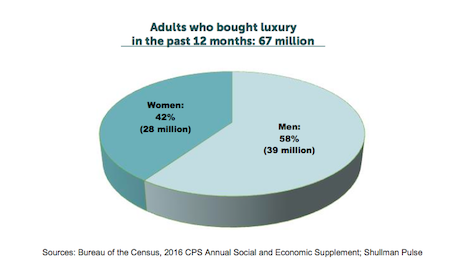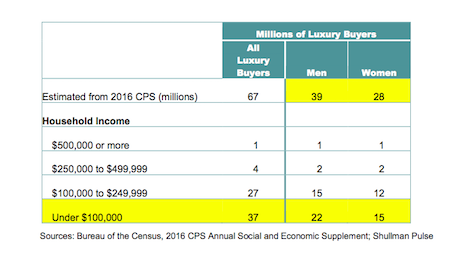When it comes to luxury spending, men are more likely to spend more and to buy things for people other than themselves, according to a new report from Shullman Research Center.
The report looked at the different spending habits of men and women when it comes to luxury and found that overall, men spent $39 million on luxury in the past year while women spent only $28 million. These disparities can be attributed to a number of factors and can influence how brands market to different demographics.
"I see the takeaway as a brand needs to really understand the genders of their customers," said Bob Shullman, founder and CEO of Shullman Research Center, New York. "If it's a male and female offering, the marketer should use themes and words that appeal to both males and females as selected word clouds in the brief show.
"If it's unequivocally a female target, the brand should use the female oriented themes and words. If it's a male target, use male oriented themes and words."
Men and women
The difference in shopping behaviors between demographics is always of keen interest to brands as they attempt to tailor their marketing campaigns to perfectly suit their target shoppers.
This is even more important in the modern age of marketing when personalized and custom messages are all the more necessary.
Deciphering the difference in luxury spending habits between men and women was the motivation of a recent report from Shullman. What the data showed was that men spend more on luxury and are more likely to buy things for other people than for themselves.

Men make up the majority of luxury spending
Fifty-eight percent of luxury spending in the last year came from men and 42 percent from women. Interestingly, the amount of luxury items purchased was around the same for men and women, with an average of 2.9 items for men and 2.8 items for women.
This suggests that men and women shop for luxury items at around the same rate with the difference being in the amount of money spent on each item.
The disparity can be attributed to a number of factors, including the wage that sees men more likely to have higher incomes than women.
This is supported by further data that shows the higher the income of the shopper, the smaller the gap in spending habits between men and women. In other words, the most affluent men and women have similar luxury shopping habits, while the less affluent shoppers display the aforementioned disparities.
Shopping habits
Another interesting fact from the data was that men are more likely to purchase luxury items for someone other than themselves than women, though for both men and women, self purchases were by far the most popular, with 79 percent for men and 89 percent for women.
This data suggests that men and women have distinct habits and ideas about shopping, specifically informed by their income levels.
For this reason, luxury brands need to be able to cater their marketing tactics to apply to the consumers they are trying to target.
This has been reflected in some recent moves by luxury brands, such as Gucci’s combination of men’s and women’s fashion into one show last year.

The disparity between men and women shrinks as income grows
Gucci president and CEO Marco Bizzarri announced during his keynote at the International New York Times Luxury Conference on April 5 of last year that the brand would begin showing its men’s and women’s wear together in a single show per season starting in this year. Fashion is trying to find a winning format for the runway show, which causes creatives at large houses to stage numerous spectacles a year (see story).
With the data provided by Shullman, luxury brands should be able to take a closer look at their marketing tactics for men and women and adjust accordingly to make the most of their marketing dollars.
"The brands and their agencies need to go out into their marketplaces and listen very carefully to how their customers and prospects discuss their categories and brands," Mr. Shullman said. "Don't think you know the appropriate messaging.
"Listen and then test what you plan to use," he said. "Last but not least, my experience indicates that female oriented brands' messages resonate better with their audiences when female creatives develop their messages as do male oriented brands when male creatives are the creatives.
"When the brand targets both sexes, have a male and female team work together and handle the creative work."
{"ct":"9d6qhKBPLaNiMx+FObyPq8x0NizdwyAkZSpt4BFTZZa05DespU3ijnRdUCInT+ZfLC5zH5uLc8X9xmtfthC07eexginqfslclXy1Oa92dLmYEP7WJKF86yI\/oSH2Odd31a7h2DzmYOw1QaVJPWJdDwGi\/QqNtm16JCOMCYL5GoweA42y6Eczlkar\/DaeBRl1afMdEYJmxMKK+F4WuGpm0muXLmeNsgIAWPvigH95SD1092nAvcb+mvncavmW3OJ3Dby7AYoq+87NVTcWBLh865XfHWo+BU+jlPPijrq2g4LVPFcmnBwlNst7dkbC0R+2EmPhiKHzs1DNhgY1T5Dy0oeIzxnrzebHm7iFPAb2+\/FVXsKzc3CG3ePzWbpJ6eiWpjIp2SBR\/ivSV8vaYJ7gm5SvhnbN00dnkCRUTyyrpTWlkhBZyUEPYHeNcKoi3Grim+XPywYaQYvP6uj+eEGJ1YV2t7M3eHUUu1Z0YwMmX0NvLf79j4QKtE7R8z\/4+P1xJ+hvOb07PWBmQ3X41278cikpib7dadazVa+bTrkIWGLn7qSrbjcSmwsA3v\/sIKDfHKbAZplUlCnedsevpLZYwcR2ElTIyoeu7uNLHcZauRf0pZ5G1N3yQrgXhgd6rTC1lrfjCdAKPwYLV8eNgBRpiv8ssVHGu8vWkRh0YXvM9TtEc\/8EEfXIPlH0BbnG9XVA3hUHiRzTr2rsE4wZQ9Kcedow3qIe+nB0rLqBT0IbiC5kIZ91kRMaSM+bd6u017v++cqVEsqtERZBKO4uSRHOBoemcTvwIVutzidLJRul\/jN3j5qrNpMHWJ1jld20esf2h+xz0Ub5J7M1XBCDZ2uX1XL0ydYc\/lcLOHrN4JaWywFK7w4GzUfB51GTAYbk12+klsx\/0wxXOK630gAwBgeEvPgRF5DlJWm3s78NM7hAlXJpM8kBQ5XbgYRIseOslcDwZgoy6IEefIWm7M2T2tNQaYn2jlVO00vVhJptASqc+5c3q\/x22Bd00lh8qBuhYGg0AiTVuNQfw7dRzAWmP1cV873ZqpJwK2xAd\/gITqH6iQLOqAR1SlTrOON53qwIhlupLDMFYY\/XIlzLCZ7Bo6Bf7edeRWlSgDHnP0vk\/qWb8WxxL0D5W9jl6ZkmNk6lvantzR0SOJavl5s7zE65YIxhCOPljBW5jWn1YjE1LNismZDD9V3emw9DzTGFkGVkVVMGPf97b6Z7tHCGRTSeVCcGh+uUlIbi6Y7FT7aBXJPnQIKLLDE+gMHr+RoZIAAQR8F8wBp9Q3KkpHk2bHdb57OtmycK0VzVowrdKfNsiliL9d2gIJTPy5y1KYS0dzoNAKVuXyc\/2NPdC+1+ribm4hTZgpVi8d4t5IDH1mhBnl0AEA9zS70+1kKxSo1nLWAAztDYRxQpR\/Pqb52eQXHDwFOYag5GNqaEpub67\/PXjihhjrCEVZue0osiqUq5KbB6jSVBddyyU5f+yKji9kr6W6t53KNX2M7E4yHqitR+1StELA8iRYpoD3F4rHSNtz11NguEJmL3GasvWMp8WsdVMCyt+AFwEY3o8rutRAcbriMoDli7F9OjocpjngLh2vkORTJDw+Er+mjPYdzXeNpJtu5lAP6cYs4J+dmdFHneL+5ImDxBbYYrdX0Ft6Jbt1PHkWBjZLnJj13JmftTN140wSJaFD9sVJq6Aw9iUyoTr1cBrAArw4yeFOW\/jBs8Rxp42JgXnGcmE3siHl1GTU4LiD95pS+OoPrMtmMy2+334+lOove0vCv5xZvTZQfq8n1NhpDCI589EUbxmSMKF0gCw64ebLs2CWoH4p+oZVjKm4YwTwcbiNmW80HpZMq01OSqh6ASgIu45w5yShIgvKXrKfoi8s3PX2ZbpycapYjcC\/H3XRcbaOauArBLm2mohjIhHMmmzVvxoT4i2AyjGy5I0KNMaZK8Otjy510xJjWttX0PFystT18yOVUUgsg1glRAJTXBGArDB4csYsykUs6ji5UMFPROyTVoufze\/enuImBr9SjWUwN7PJgvMZRkYrc9xkSy6Jhd6HYy3YDNktj\/lPrtSl1S4rOkSPzwpJLCuwR15n1LX96yJh0LyKydXkmIbbUpLD6cqz7AldDKg6E7H05C8ZeEO4aqHZ8WitLHF2jVeKXkw5vI8C1AczMnHfn82c708Xhyzq5aKLwtStCytt6QgjtT1veQt9AyrLfmDzmC+cxXyVfR3hWdVUDf1Pb3qwBUwFJKvOhO5vEE55G29zpiURRng\/ReZ4xzWvftSdvZ6puw\/vJWuSI+lomzdajNvh6cIXP0D4bqyrBQGVtoL0g0qQzMPKJEs3cFr1rQmQ\/nel6QDc7Ucdr1j6TMm7CvrPlafiWx2jIeX6vDIsMf4q2KL2xbZxXxpv\/htClHbJybgmmQlReL7BsBUkTebmE+tG91F0pBKhNTiPtm+1hdOtFBGFGYfS1LoHZ6IpKq9vq93U0ytfHpykMIRjEDtRVXYFfwZ3g6jRzYcqaEmsaxO8P0ig6dwXUBj5NxGekXggj50jcx7h0bff+rIc9JTpBiN2Sy0wipI+cDEmSiyjEoiUmkVyPrqFeHrdcW8dHu+FKVFyZIt+\/Yb4w4EpTq4LhAQSMiGJd9ruYxtNqLioiaX3b0VLbAETB6XPKovWex\/Z0oHhAJStE9MkgFyRjSgrgdCjVPJhrKFekmYmgYbnF0Rlw1mSb8G6lk7BtSLgaqZz8zpDimZWHD6DuCNtBY1MCJeiWmfpakbz4zB8WwWER7sLO39qLiLDpDouRb44P8dIAZ3J9m3BGwyE8SatuYhDl7R+X7euHSn2BK8I0LAO+g\/EFtAuHfPGqVP+xgcyX2u\/KA4inksHUrBONJ9kN\/0JBxHbFtmPl5q5XCAwnFZw4eWMbREg8A6htpIW9ciCp6+C\/Ta32DyAPkBSLBwanTyMqZNp3N6UofNICS4OJg4YVnYd9zBIo5SzbwKZyQWXfHfIVmX0R5jREADbICjVoO6mmTpAYmplbDH+N76rSynnMFbtMgMOHQlqwCipMBuMQVY4QNFqeHRz9Mj1pPj4pya03PMr2RkfaHysSIyYNnCYa\/5NdEMSnU6ydEYXwKLWu9uCB7cnh9n8qXUPcw0mOU967h9yw3DLUlwkq+FLOp\/VvbUoRc5\/j4WBgE4iuatW0JL5P4Y\/4MkLrWBrq6ThEC+i2ye9ZqAguCdiLZuklJdV4So2M40G0utW79hx9eK6fv6gFGVE4RG0Whzv5FufCx4bEv1GR7x6zDWC0CoDgIReGFVWdS2Ot4NcHdT7VuDDGJo6aM\/dVc8yAqRjPpL1k0le1+QzDtCnQYZAtNgEvHuu547KI9h3ihXL1Sb1Wu1s1yjF8OVlwrpVob\/RD0k9U0xylLudtmT7RG6N849HItlwa4ZWAhRC2\/qVFoTe4T7WmYo+qgl2ezSG5fJoHr+ZrXlmGUkIRjAgsqtznpBPf7YRx8Vm5Ki7FuSqNGwUz3KwhyflC7PHki6gOyP5MyT7g6kGBgE2U7a87Syscb6JEzZ\/Em9rBTkSUgmWQE9nh\/4V91jpQ99Se3U2iLyUD\/lyXlRiAJKc64BvSruwiwHtcTUkVp7onhASNyR8iMqs99IrYO0nWjJ9GNkO\/azu\/I5Csw9X+pT+TmGiogXUOcFeraV9\/7MWjktpknl8A1mxd3nhKCH\/zkeyHlqbD+VA3s1yu5E5hncCw6dwcXWvPa2KhYy5KPQ1wQnQQtP5M7FZk9ZjsXZoSaqokFA0KfMWXK5hOAQZ6D9X4PmieGM9MbrzbHdSegpEWXx3DuHyzvwLZ09\/MJXpKsHa1BgH5+3mObV3CLPsRW3T968WmYdo3e89HmSZL9CqYIy2flmTt1dgyrRSeE2PYwjEcEtdC7Oi\/mLL\/4kY2dykgAQG3uICdwyvJHe1P\/29O2s2\/XzCfHlgHQ3KU6r\/ukT6cmyR4Q0vOSSf++\/YKgCvXurbc4Jyq8T5M92sQigWEgKNdupTXN2kOK6HlbEF8L+qd6tC7M++44aVuPXlz97erL33LGqHH\/B81MHVMQo29Xu0qpHVmQmQ5gEZlqj4xE9zkJmxt7mQ7jG1z25xxR4VPemXMKJS+klLAnPAE8iwPOOZSVbZrk8m\/sFftaqfh+sukgrD9FiNZFAx77YwhqUQOft8ZqOrtFNQa0ECdI3p95w+Gx56aT1ozXFkmah0XI8XG8lSbVgHKP4gCyJ0hxyBTsz1RilIVf6NeVmHh1Rzoi6erS4RqzGwEnhfCrmff2Qkcn022CZaw6DY5jx21PLgFec0d9FoxEdyYOYAMaCdLZB75OooyG2Qz4KjTe3DOLSPZdXZ1qT4dwJT1N1yjYuGwp8kXY7OhrA2gdLpHdyK\/vEwsc9fCPEf4FWUfb+ruy1gnPGwE15CWBbtPONZ9IhJfjWy8qPMulHVSoC8PPQ++EXwFJBGh5KXhTYmKKea5YB4xwEhj8pBM3oc1CqeYHVzuatawSQNvF+4a5IaXUflsYcsebeVJ3H20PwqoULwLyQcgDl8K9MOVALWpOsP\/q21hr7oNrP5U6EbD\/yhJumxdWI1w5Bx8oGyKZ9kRSLvJDBqdPlIfU75iAzam0uZCcLUEDTHH0gvC7YWO3lcqc\/\/5gQvhCR\/ztbVQ1RqbeMjjWOEX5zaIlUYpDXDccovJwGUg4xgwEWMTqYlOtomtC\/2RvAv2jsiQEscRoPfGHL4aVOX7J9GzelrFmzgq7I8138DP9oQQDlfcgPH0lSGNWzC2NSuLQ9cfTZgKJyBhke4I7h982Smu07u4QgK0TZbHHxhQc1+PhVtx50FKtXmFc5EriNZ+Dp+r4z+VmHxjTfbpATJPL192s5crNC9FKzP1zoiDJW6\/oHCh94qPZjBzL3a\/mQSm4udo9wnQ0Qu3ukuu4pXW9JHnG1Ab+x3XAl+mC7Gin5hzktEq4dsU2XXV0BUjNYFfxW5vnH1osIn8w9u2dtq\/d1vE7uLmagPFewFY7pz\/Qm4zZZJglLM1wbvGFtmZwPnrlXJERWIF4dltUIRPY2yHDYfD08bIqYUPQ9mbXC7YVPNjRz+tHBVD5sD5IZtUswhgWMPP5mvlKAEsJXZU+CjrdcOZuF1SSQR0Eb8CtEmVWGbisFK4GGXdl+NJSZ\/2RNA69mhIOVbc2Nl+4Rk1fhGCqXQSU0xJg5gnnoPVHqV8S3BVJRGy8PdDR88fbqbB+42ihToskdFNL+riE3pQx8yVtMHFj72I71rxtPOj2PyU7sPN27Nw3c3ub4vsJE7xjF7LADXkjtyUhYmxYFAexTqgv6IBvclmbmJfkfYYYn7VXMx2DS2NFc+yJciNRvEk2V8I9Dv01rms6SfRite\/0XF5pMgZGxlrZ5sK9JOLlYBhaUyVUrE2QpZiuDq7Z9WAaQWd6du4YGY6MIDLwodf2Xkn+HfUR0NcM8R3fardhDmWaSpI4d7a4Fej4lLWWnoJZPhrR96jM9GC4reG52ChGZmLUMuORZQReF8SuIbcGUbYGUc6yesVh0pqIzPgQe6qU4nJotl7Lm8MiHxKZRbnoBWg6dW2s+LqBT0qaYcn1s8fa+sCfh3I2hmrdY3IXknLm9aWE7w3YsfNCQrDeKSm1luUT7Pr4Z0B+jCfbZC2b60NnxxrOVaUmAlFjH6wKkyEuXCASqkp6dwxVOnfE+gRDIraBUywdgx7yTPHd4VJp3SU89kbp4TcvskmNcZ+GGoQumqxr5s6+n3z8bxtteWSymSC07ZCJfJ3nTb8UH2zBrdyHUv76ISH26ymqxoIvp7ZLrneK5OkOQu\/LuvYepeeUy8y6W2n5cUDHoESG+qX5ZLcwJFN0GUdQWBHyhKQq7Q69cvfRf7mj9dnci0SUpbUb1DH4mqqNPSPoJhWdLxqqMRrkg+oFRQMx4iUal5nkbcHaSW4JwV5bCeV1DKDHx7GFsqjHfmtvWHcVQWrQHYZbNZ7lHxH3zQaiUBaaWVO+fqNEc5JRz2yHy8Y\/cGZhBJIg5OOndJxHwxl\/XVUUrMg4w7ilhqJEs8vf0hE6sA+X5\/9KIcQ3vJORlTTtPz7O3T5wH90vuiuPq2pOeoVuYgLjTSumMBZBIygNgRFJqc5m7Mjw1\/RVWiXqBhLAaZ4bV65Sj32whKUFD3\/3ukV0j6Q5a0zYyyl3aGtfTki+Lo2vnWSLlLshCmLabbrp9N2iQJJicjH9BrbQYFMLxL88gVf+1u1sFnT2TctXOMqiT8ayviQUlroGvof8BU+naH6VK2DY8THOFtzFilff0ulon5Rqnv+qKPCjmHek1lPPYNO\/Acmxqh6ok3QevMql5cYoQCGE\/LErve1dA4kWr2BkpEpDqMOVmjU7HlxWsbnIEPnp6W4nHHuKdjT3rjNRKOiF16VhTjr3wGRAhyNd6bE0CRpj5yt3I8rXhc+GrGxHrAAxSyOzyRbUusB87QMq3aYDKRU10etVFrH74oKuThe8W28R2y1jXCSzaJMEqJv\/+o+SMC6bBD9STdTC4bdGkqVdr7DvpCmCWsmxzaZVqeaATMNqQ\/lqXjyerjgwwWJQpL2kTCWCyiLJTTr5C7lzimPF7SZzJ8NLXtIoQhyBeHKlAd4Y0loK3Aa2Jz6Q8sPCHtN7AoXZjhTpXl4ar6RU0iVzr7U4IjyJI4zMoCZZWTu1ETMDCD\/LAH83\/vopqO4hQIvxgiJhrAKyCJeWkqxLcKn6XOyPFBAD+g8pvcCX8RNDWxKp2YXmY5oWLAcUG8DMsd8U01KJ4+GkQvOSvdMtpSdKscVZ76eiQ09RLfs2mMNDwmdG6Nf7CSXZQhGR47Ol2CqIU6crbtrPB5JD8GyoXaw\/hez3loBe4zEa8WeBYr+AwuLeHpfwKCqeUGFrDE+eW24c98m\/tpbKh+L7ri60HiSmpSbwqSnd3ZQqu\/8\/nF6pwvQtbJGaduoj7ApfBLWLzga\/Fi2McrGEB5nXFoNAg7y25nP0WEBJNN9CEykalhIT+5hdYJeefujwKkEvC6d4McV7AJvD0ex8hGdeiqJnJEn\/bVIH1atCK0aXWcxfZXtjR38qHVVqxBcQ2s84IbSBeoFrKAiFPCn+PYso2tOvaFVDScy5yj4pU\/kFQ\/6vMLq9HEzNu4VH5ubbF66aWCRfzKtrMXwnmlGExWN25eu+AoJHpiD5mVJvVyTuHCieFU88YYWKv9KjC2HV\/zC5ZhOQco3R2\/JkI9+BDVoMMKUaoOKztx6FaJAMO90PFU8WH2kC7+rkONm\/u9Un+xijh\/3tsVsOwAosAHMu8fdDGF+OTm\/yMGdG2mLSEg1f\/DWmJHZv0gSSRM2kpznl0kdN8FITrbSdOQR9MbrzQMQORRVYlYLBaeyC38YaBAXoXyqTyi+NYEoMzzAqCSh8QWOxtsaP+mKKBTFOoEf0hAxLvwNA6QeqRZHQqqOA2l6inbtkO+zQjMaklmgWjr4nLrmOzZ0AZYXLAvzFmPpNurh\/DRH+hQtqDgEal9uBwgcZz0CNgnjuxeiMVdJtTNofU5wazJHuIAilW3hXxercAUj5zoqxDAxlvpv+9PfgdiLhOCWaCatZfeQU9ty4PzlCUzB0iFiQlCeix5HxzplepKwnfpQDbFvIWuM\/vQ1UX7Bg8Yq+jRN23PqDjjb7UFpIv14XulJlgecSYsVVU9cOuQas4HS0kN+wadA\/cDLhuHHok39\/mMuUEqw4akOo","iv":"ba87b32edd1c629a37cfbda178f8d9a5","s":"8369d4edc7b44d88"}

 Men and women have decidedly different luxury shopping habits
Men and women have decidedly different luxury shopping habits